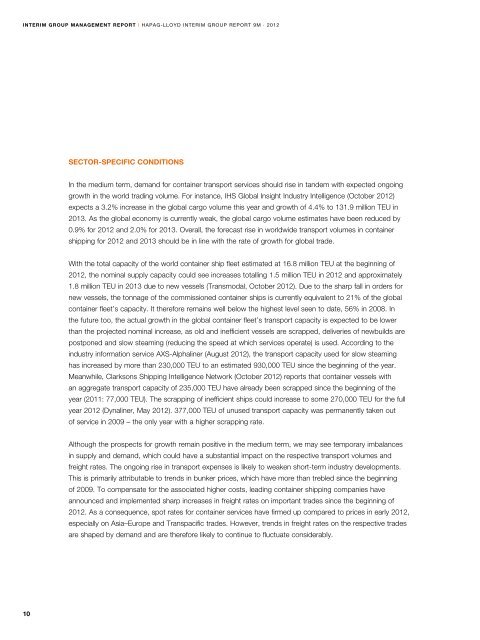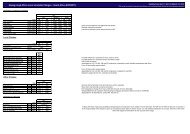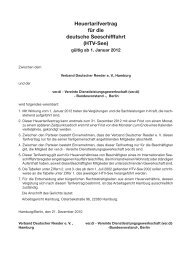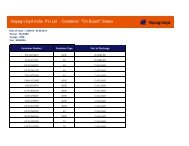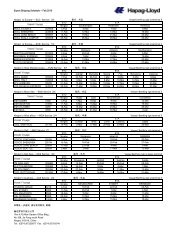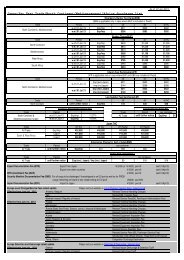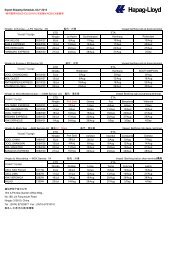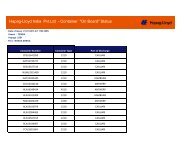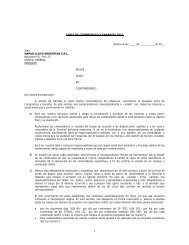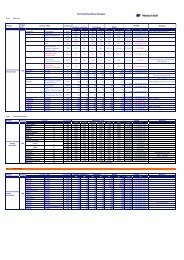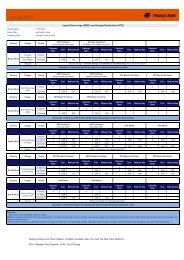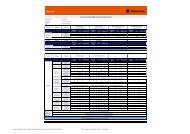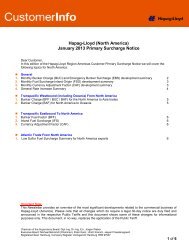Open print version - Hapag-Lloyd
Open print version - Hapag-Lloyd
Open print version - Hapag-Lloyd
Create successful ePaper yourself
Turn your PDF publications into a flip-book with our unique Google optimized e-Paper software.
interim group management report I hapag-lloyd interim group report 9M · 2012<br />
Sector-specific conditions<br />
In the medium term, demand for container transport services should rise in tandem with expected ongoing<br />
growth in the world trading volume. For instance, IHS Global Insight Industry Intelligence (October 2012)<br />
expects a 3.2% increase in the global cargo volume this year and growth of 4.4% to 131.9 million TEU in<br />
2013. As the global economy is currently weak, the global cargo volume estimates have been reduced by<br />
0.9% for 2012 and 2.0% for 2013. Overall, the forecast rise in worldwide transport volumes in container<br />
shipping for 2012 and 2013 should be in line with the rate of growth for global trade.<br />
With the total capacity of the world container ship fleet estimated at 16.8 million TEU at the beginning of<br />
2012, the nominal supply capacity could see increases totalling 1.5 million TEU in 2012 and approximately<br />
1.8 million TEU in 2013 due to new vessels (Transmodal, October 2012). Due to the sharp fall in orders for<br />
new vessels, the tonnage of the commissioned container ships is currently equivalent to 21% of the global<br />
container fleet’s capacity. It therefore remains well below the highest level seen to date, 56% in 2008. In<br />
the future too, the actual growth in the global container fleet’s transport capacity is expected to be lower<br />
than the projected nominal increase, as old and inefficient vessels are scrapped, deliveries of newbuilds are<br />
postponed and slow steaming (reducing the speed at which services operate) is used. According to the<br />
industry information service AXS-Alphaliner (August 2012), the transport capacity used for slow steaming<br />
has increased by more than 230,000 TEU to an estimated 930,000 TEU since the beginning of the year.<br />
Meanwhile, Clarksons Shipping Intelligence Network (October 2012) reports that container vessels with<br />
an aggregate transport capacity of 235,000 TEU have already been scrapped since the beginning of the<br />
year (2011: 77,000 TEU). The scrapping of inefficient ships could increase to some 270,000 TEU for the full<br />
year 2012 (Dynaliner, May 2012). 377,000 TEU of unused transport capacity was permanently taken out<br />
of service in 2009 – the only year with a higher scrapping rate.<br />
Although the prospects for growth remain positive in the medium term, we may see temporary imbalances<br />
in supply and demand, which could have a substantial impact on the respective transport volumes and<br />
freight rates. The ongoing rise in transport expenses is likely to weaken short-term industry developments.<br />
This is primarily attributable to trends in bunker prices, which have more than trebled since the beginning<br />
of 2009. To compensate for the associated higher costs, leading container shipping companies have<br />
announced and implemented sharp increases in freight rates on important trades since the beginning of<br />
2012. As a consequence, spot rates for container services have firmed up compared to prices in early 2012,<br />
especially on Asia–Europe and Transpacific trades. However, trends in freight rates on the respective trades<br />
are shaped by demand and are therefore likely to continue to fluctuate considerably.<br />
10


